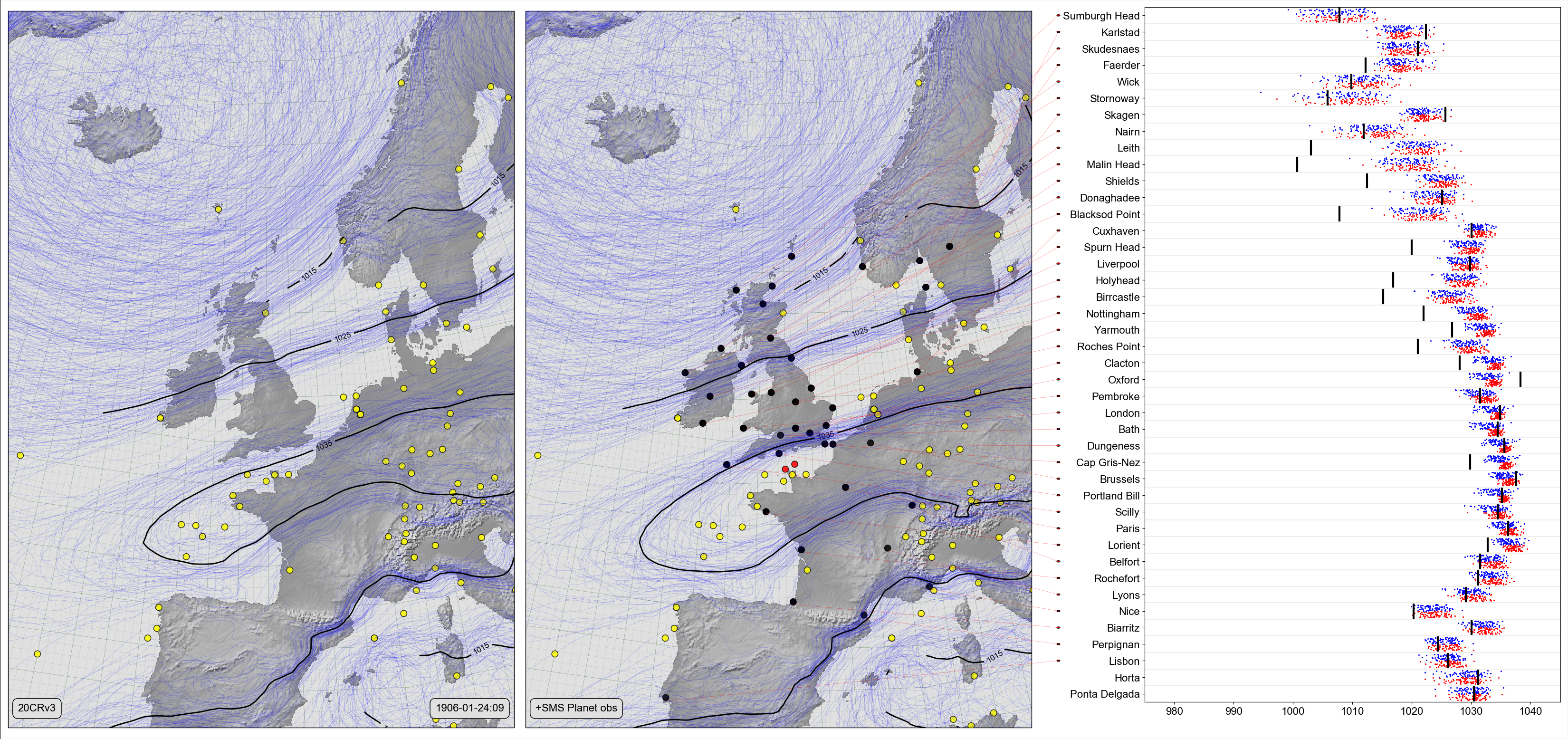Ship observation assimilation: SMS Planet in January 1906¶

On the left, a Spaghetti-contour plot of 20CRv3 MSLP at 9 a.m. on January 24th 1906. Centre and right, Scatter-contour plot comparing the same field, after assimilating the SMS Planet observations within 4 hours of that date. The centre panel shows the 20CRv3 ensemble after assimilating the ship observations (red dots), and also DWR stations for the same date (here used for validation and not assimilated). The right panel compares the two ensembles with the new observations: Black lines show the observed pressures at the validation stations, blue dots the original 20CRv3 ensemble at the station locations, and red dots the 20CR ensemble after assimilating the ship observations.¶
Code to make the figure¶
Collect the reanalysis data (prmsl ensemble and observations from 20CRv3 for 1906):
#!/usr/bin/env python
import IRData.twcr as twcr
import datetime
dte=datetime.datetime(1906,1,1)
for version in (['4.5.1']):
twcr.fetch('prmsl',dte,version=version)
twcr.fetch_observations(dte,version=version)
Plot the figure:
#!/usr/bin/env python
# Assimilation observations from SMS Planet
# Validate against DWR observations for the same time
import math
import datetime
import numpy
import pandas
import iris
import iris.analysis
import matplotlib
from matplotlib.backends.backend_agg import \
FigureCanvasAgg as FigureCanvas
from matplotlib.figure import Figure
from matplotlib.patches import Circle
import cartopy
import cartopy.crs as ccrs
import Meteorographica as mg
import IRData.twcr as twcr
import DWR
import IMMA
import DIYA
import sklearn
RANDOM_SEED = 5
from collections import OrderedDict
obs_error=5 # Pa
model=sklearn.linear_model.Lasso(normalize=True)
# Date to show
year=1906
month=0o1
day=24
hour=9
dte=datetime.datetime(year,month,day,hour)
# Landscape page
fig=Figure(figsize=(22*1.5,22/math.sqrt(2)), # Width, Height (inches)
dpi=100,
facecolor=(0.88,0.88,0.88,1),
edgecolor=None,
linewidth=0.0,
frameon=False,
subplotpars=None,
tight_layout=None)
canvas=FigureCanvas(fig)
font = {'family' : 'sans-serif',
'sans-serif' : 'Arial',
'weight' : 'normal',
'size' : 16}
matplotlib.rc('font', **font)
# UK-centred projection
projection=ccrs.RotatedPole(pole_longitude=177.5, pole_latitude=35.5)
scale=12
extent=[scale*-1,scale,scale*-1*math.sqrt(2),scale*math.sqrt(2)]
# On the left - spaghetti-contour plot of original 20CRv3
ax_left=fig.add_axes([0.005,0.01,0.323,0.98],projection=projection)
ax_left.set_axis_off()
ax_left.set_extent(extent, crs=projection)
ax_left.background_patch.set_facecolor((0.88,0.88,0.88,1))
mg.background.add_grid(ax_left)
land_img_left=ax_left.background_img(name='GreyT', resolution='low')
# 20CRv3 data
prmsl=twcr.load('prmsl',dte,version='4.5.1')
# 20CRv3 data
prmsl=twcr.load('prmsl',dte,version='4.5.1')
obs_t=twcr.load_observations_fortime(dte,version='4.5.1')
# Filter to those assimilated and near the UK
obs_s=obs_t.loc[((obs_t['Latitude']>0) &
(obs_t['Latitude']<90)) &
((obs_t['Longitude']>240) |
(obs_t['Longitude']<100))].copy()
# Plot the observations
mg.observations.plot(ax_left,obs_s,radius=0.15)
# PRMSL spaghetti plot
mg.pressure.plot(ax_left,prmsl,scale=0.01,type='spaghetti',
resolution=0.25,
levels=numpy.arange(875,1050,10),
colors='blue',
label=False,
linewidths=0.1)
# Add the ensemble mean - with labels
prmsl_m=prmsl.collapsed('member', iris.analysis.MEAN)
prmsl_s=prmsl.collapsed('member', iris.analysis.STD_DEV)
prmsl_m.data[numpy.where(prmsl_s.data>300)]=numpy.nan
mg.pressure.plot(ax_left,prmsl_m,scale=0.01,
resolution=0.25,
levels=numpy.arange(875,1050,10),
colors='black',
label=True,
linewidths=2)
mg.utils.plot_label(ax_left,
'20CRv3',
fontsize=16,
facecolor=fig.get_facecolor(),
x_fraction=0.02,
horizontalalignment='left')
mg.utils.plot_label(ax_left,
'%04d-%02d-%02d:%02d' % (year,month,day,hour),
fontsize=16,
facecolor=fig.get_facecolor(),
x_fraction=0.98,
horizontalalignment='right')
# In the centre - spaghetti-contour plot of 20CRv3 with DWR assimilated
ax_centre=fig.add_axes([0.335,0.01,0.323,0.98],projection=projection)
ax_centre.set_axis_off()
ax_centre.set_extent(extent, crs=projection)
ax_centre.background_patch.set_facecolor((0.88,0.88,0.88,1))
mg.background.add_grid(ax_centre)
land_img_centre=ax_centre.background_img(name='GreyT', resolution='low')
# Get the DWR observations for that afternoon
obs=DWR.load_observations('prmsl',
dte-datetime.timedelta(hours=13),
dte+datetime.timedelta(hours=13))
# Throw out the ones already used in 20CRv3
obs=obs[~obs['name'].isin(['ABERDEEN','VALENCIA','JERSEY','STOCKHOLM','BODO',
'HAPARANDA','CHRISTIANSUND','HERNOSAND','WISBY',
'FANO','BERLIN','THEHELDER','BREST','MUNICH','FRANKFURT'])]
obs.value=obs.value*100 # to Pa
# Get the SMS Planet obs close to this time
ship_obs=[]
ship_source=IMMA.get('Planet_1906-7.head_100.imma')
for ob in ship_source:
if (ob['YR'] is None or
ob['MO'] is None or
ob['DY'] is None or
ob['HR'] is None or
ob['LAT'] is None or
ob['LON'] is None or
ob['SLP'] is None): continue
ob['dtm']=datetime.datetime(ob['YR'],ob['MO'],ob['DY'],
int(ob['HR']),int(60*ob['HR']%1))
if abs((ob['dtm']-dte).total_seconds())>(3600*4): continue
ship_obs.append(ob)
# Convert the ship obs into a pandas dataframe
ship_obs=pandas.DataFrame.from_dict({
'name': [ ob['ID'] for ob in ship_obs],
'latitude': [ ob['LAT'] for ob in ship_obs],
'longitude': [ ob['LON'] for ob in ship_obs],
'value': [ ob['SLP']*100 for ob in ship_obs],
'dtm': [numpy.datetime64(ob['dtm']) for ob in ship_obs] })
# Update mslp by assimilating ship obs.
prmsl2=DIYA.constrain_cube(prmsl,
lambda dte: twcr.load('prmsl',dte,version='4.5.1'),
obs=ship_obs,
obs_error=obs_error,
random_state=RANDOM_SEED,
model=model,
lat_range=(20,85),
lon_range=(280,60))
mg.observations.plot(ax_centre,obs_s,radius=0.15)
mg.observations.plot(ax_centre,obs,
radius=0.15,facecolor='black',
lat_label='latitude',
lon_label='longitude')
mg.observations.plot(ax_centre,ship_obs,
radius=0.15,facecolor='red',
lat_label='latitude',
lon_label='longitude')
# PRMSL spaghetti plot
mg.pressure.plot(ax_centre,prmsl2,scale=0.01,type='spaghetti',
resolution=0.25,
levels=numpy.arange(875,1050,10),
colors='blue',
label=False,
linewidths=0.1)
# Add the ensemble mean - with labels
prmsl_m=prmsl2.collapsed('member', iris.analysis.MEAN)
prmsl_s=prmsl2.collapsed('member', iris.analysis.STD_DEV)
prmsl_m.data[numpy.where(prmsl_s.data>300)]=numpy.nan
mg.pressure.plot(ax_centre,prmsl_m,scale=0.01,
resolution=0.25,
levels=numpy.arange(875,1050,10),
colors='black',
label=True,
linewidths=2)
mg.utils.plot_label(ax_centre,
'+SMS Planet obs',
fontsize=16,
facecolor=fig.get_facecolor(),
x_fraction=0.02,
horizontalalignment='left')
# Validation scatterplot on the right
obs=obs.sort_values(by='latitude',ascending=True)
stations=list(OrderedDict.fromkeys(obs.name.values))
ax_right=fig.add_axes([0.73,0.05,0.265,0.94])
# x-axis
xrange=[975,1045]
ax_right.set_xlim(xrange)
ax_right.set_xlabel('')
# y-axis
ax_right.set_ylim([1,len(stations)+1])
y_locations=[x+0.5 for x in range(1,len(stations)+1)]
ax_right.yaxis.set_major_locator(
matplotlib.ticker.FixedLocator(y_locations))
ax_right.yaxis.set_major_formatter(
matplotlib.ticker.FixedFormatter(
[DWR.pretty_name(s) for s in stations]))
# Custom grid spacing
for y in range(0,len(stations)):
ax_right.add_line(matplotlib.lines.Line2D(
xdata=xrange,
ydata=(y+1,y+1),
linestyle='solid',
linewidth=0.2,
color=(0.5,0.5,0.5,1),
zorder=0))
latlon={}
for station in stations:
latlon[station]=DWR.get_station_location(obs,station)
# Plot the station pressures
for y in range(0,len(stations)):
station=stations[y]
mslp=obs[obs.name==station].value.values[0]/100.0
ax_right.add_line(matplotlib.lines.Line2D(
xdata=(mslp,mslp), ydata=(y+1.1,y+1.9),
linestyle='solid',
linewidth=3,
color=(0,0,0,1),
zorder=1))
# for each station, plot the reanalysis ensemble at that station
interpolator = iris.analysis.Linear().interpolator(prmsl,
['latitude', 'longitude'])
for y in range(len(stations)):
station=stations[y]
ensemble=interpolator([latlon[station]['latitude'],
latlon[station]['longitude']])
ax_right.scatter(ensemble.data/100.0,
numpy.linspace(y+1.5,y+1.9,
num=len(ensemble.data)),
20,
'blue', # Color
marker='.',
edgecolors='face',
linewidths=0.0,
alpha=1.0,
zorder=0.5)
# for each station, plot the post-assimilation ensemble at that station
interpolator = iris.analysis.Linear().interpolator(prmsl2,
['latitude', 'longitude'])
for y in range(len(stations)):
station=stations[y]
ensemble=interpolator([latlon[station]['latitude'],
latlon[station]['longitude']])
ax_right.scatter(ensemble.data/100.0,
numpy.linspace(y+1.1,y+1.5,
num=len(ensemble.data)),
20,
'red', # Color
marker='.',
edgecolors='face',
linewidths=0.0,
alpha=1.0,
zorder=0.5)
# Join each station name to its location on the map
# Need another axes, filling the whole fig
ax_full=fig.add_axes([0,0,1,1])
ax_full.patch.set_alpha(0.0) # Transparent background
def pos_left(idx):
station=stations[idx]
ll=latlon[station]
rp=ax_centre.projection.transform_points(ccrs.PlateCarree(),
numpy.asarray(ll['longitude']),
numpy.asarray(ll['latitude']))
new_lon=rp[:,0]
new_lat=rp[:,1]
result={}
aspect=math.sqrt(2)
result['x']=0.335+0.323*((new_lon-(scale*-1))/(scale*2))
result['y']=0.01+0.98*((new_lat-(scale*aspect*-1))/
(scale*2*aspect))
return result
# Label location of a station in ax_full coordinates
def pos_right(idx):
result={}
result['x']=0.675
result['y']=0.05+(0.94/len(stations))*(idx+0.5)
return result
for i in range(len(stations)):
p_left=pos_left(i)
p_right=pos_right(i)
if p_left['x']<0.335 or p_left['x']>(0.335+0.323): continue
if p_left['y']<0.005 or p_left['y']>(0.005+0.94): continue
ax_full.add_patch(Circle((p_right['x'],
p_right['y']),
radius=0.001,
facecolor=(1,0,0,1),
edgecolor=(0,0,0,1),
alpha=1,
zorder=1))
ax_full.add_line(matplotlib.lines.Line2D(
xdata=(p_left['x'],p_right['x']),
ydata=(p_left['y'],p_right['y']),
linestyle='solid',
linewidth=0.2,
color=(1,0,0,1),
zorder=1))
# Output as png
fig.savefig('Planet_%04d%02d%02d%02d.png' %
(year,month,day,hour))
